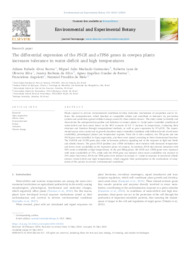The differential expression of the P5CR and ?TPS6 genes in cowpea plants increases tolerance to water-deficit and high temperatures.
The differential expression of the P5CR and ?TPS6 genes in cowpea plants increases tolerance to water-deficit and high temperatures.
Author(s): BARROS, J. R. A.; GUIMARÃES, M. J. M.; SILVA, R. L. de O.; SILVA, J. B. da; BARROS, A. A. G. de; ANGELOTTI, F.; MELO, N. F. de
Summary: Plants exposed to adverse environmental conditions develop molecular mechanisms of adaptation and/or defense, the osmoprotectors, which function as compatible solutes and contribute to tolerance via prevention systems and protection against cellular damage caused by these abiotic stresses. This study aimed to identify and characterize the osmoprotectors proline and trehalose in cowpea plants cv. Carijó under controlled conditions of water-deficit and heat stress based on the IPCC scenario of 4.8 °C increase in temperature, evaluating their structure and function through computational methods, as well as gene expression by RT-qPCR. The experimental assays were carried out in growth chambers under controlled conditions with different levels of soil water availability, phenological phases and temperature regimes. From the in silico analyses, ten TPS genes and one P5CR gene were identified in Vigna unguiculata, and these were named according to their chromosomal location. The VuP5CR and VuTPS genes play roles in hormone pathway signaling and in the response to light and biotic and abiotic stresses. The genes P5CR (proline) and ?TPS6 (trehalose) were induced with increased temperature and lower water availability in the vegetative phase of cowpeas. In addition, P5CR also showed induction with 50% water availability at high temperatures. In the pod filling phase, the P5CR and ?TPS6 genes were repressed with water availability of 75%, while only the P5CR gene was induced when water availability was reduced to 25% under heat stress. P5CR and TPS6 genes were induced in cowpea cv. Carijó in response to associated abiotic stresses (water-deficit and high temperatures), which suggests their participation in the mechanisms of adaptation of the species in adverse environmental conditions.
Publication year: 2024
Types of publication: Journal article
Unit: Embrapa Semi-arid Region
Observation
Some of Embrapa's publications are published as ePub files. To read them, use or download one of the following free software options to your computer or mobile device. Android: Google Play Books; IOS: iBooks; Windows and Linux: Calibre.
Access other publications
Access the Agricultural Research Database (BDPA) to consult Embrapa's full library collection and records.
Visit Embrapa Bookstore to purchase books and other publications sold by Embrapa.

